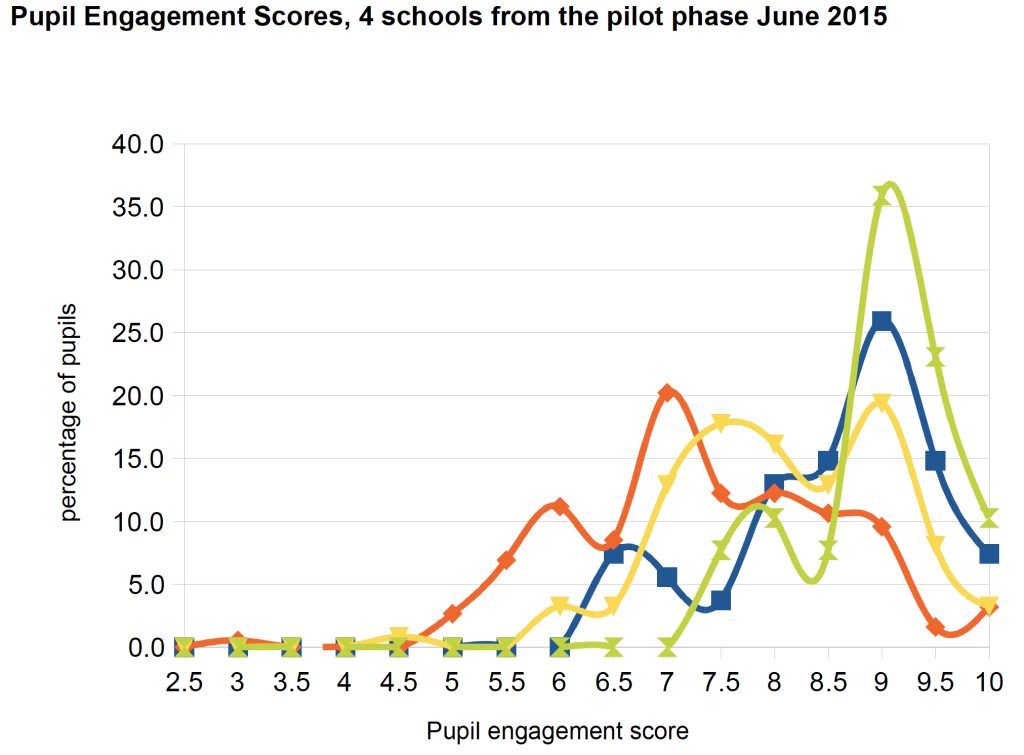The pupil engagement survey was trialled with schools that had gained the Naace Third Millennium Learning Award. As these were schools adjudged to be providing exceptional education we expected high engagement. But even with these schools the survey revealed very interesting differences. The survey was taken online, courtesy of Frog Education. It was anonymous so there was no reason for pupils to give answers not reflecting their true feelings. The schools arranged for their whole school cohort to take the survey. They were all primary age schools.
The tool is a self analysis tool for schools. It could be used with year groups or classes but would be far less revealing about the overall school culture of engagement, which is sensed immediately on arrival when pupils join a school. In agreeing to do this survey the school is giving pupils the opportunity to tell the schools that they don’t like it. That a school is not willing to do the survey is revealing in itself. It tells you that the school leaders consider what the pupils think of the school to be unimportant.
The pupils were presented with five options for each question.
How often do you do these things?
- A lot
- Quite a lot
- Sometimes
- Hardly ever
- Never
The questions are:
- I like learning.
- I like coming to school.
- I show my work to other people and like getting their comments on it.
- I look at how my work is getting better and see how much progress I am making.
- I help others learn things that I am good at.
- I find out about things and learn about them myself
- I work with other pupils to help me learn.
- I help younger pupils to learn.
- I choose how best to use technology to help me learn.
The questions are designed to test how well a school is implementing the ‘virtuous spiral‘.
- I like learning. – testing engagement with learning.
- I like coming to school. – testing general engagement with school. You can like school as a social environment while feeling you are not good at learning.
- I show my work to other people and like getting their comments on it. – are pupils comfortable with displaying their work for constructive criticism by others? Is the learning collaborative?
- I look at how my work is getting better and see how much progress I am making. – how good are the teachers at recording progress, even if slow, and convincing pupils that they are making progress?
- I help others learn things that I am good at. – Is there the concept in the school that not knowing something entitles you to help from others, that learning is collaborative and an excellent way to learn is to teach others?
- I find out about things and learn about them myself. – Are the pupils taking personal responsibility for their learning?
- I work with other pupils to help me learn. – that not all learning has to involve the teacher teaching, that pupils can lead learning.
- I help younger pupils to learn. – that peer tutoring cross-years is happening.
- I choose how best to use technology to help me learn. – that the pupil is in control of if and when to use technology and not dependent on what the teacher dictates, at least some of the time.

The green school has high engagement from the majority of pupils, a small group a little less engaged and none with very loiw engagement.
The blue school is similar but with a little less engagement from the less engaged.
The yellow school has two groups who may exert different kinds of peer pressure, about a third of pupils highly engaged but two thirds only moderately engaged (though remember these are schools with generally high engagement.
The red school has generally lower engagement, few highly engaged, a worrying group with fairly low engagement, and a troubling outlier scoring 3. I hope the school knows which pupil this is, even though the survey was anonymous, and that they have identified the reason for this almost total lack of engagement.
